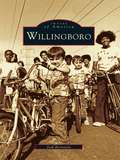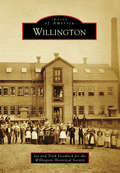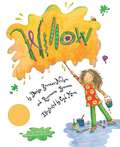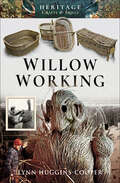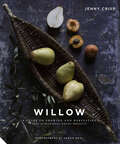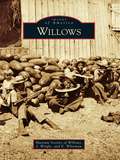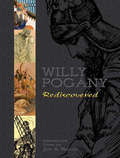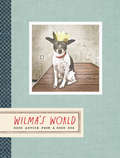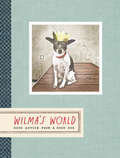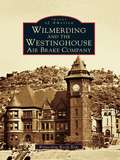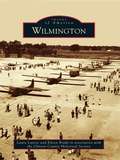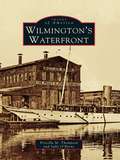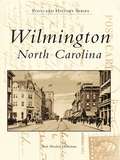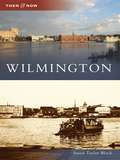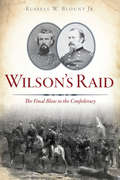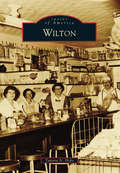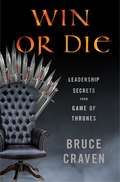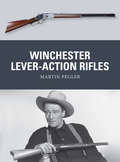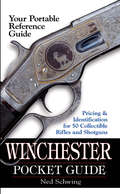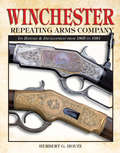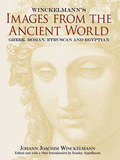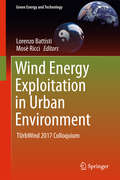- Table View
- List View
Willingboro
by Josh BernsteinLocated between Philadelphia and Trenton, Willingboro has a three-hundred-year history of forward thinking. Founded in 1688 by Thomas Olive, a Quaker who left England seeking religious freedom, Willingboro evolved from an agricultural community longing to rid itself of British rule to a suburb unique in the United States. Using many vintage photographs and historical documents, Willingboro chronicles the rich lives and experiences of its residents, including William Franklin, the last royal governor of New Jersey, and track star Carl Lewis. This volume explores Willingboro's beginnings as a quiet farming community, which was a planned Delaware River crossing site for Washington's army during the Revolutionary War. Close to two centuries later, a Long Island developer replaced the farms with eleven thousand affordable homes that became America's third Levittown. Willingboro is the finest example of post-World War II suburban planning, affirmed in 1960 by the Westinghouse Corporation's decision to use the town as the backdrop for its "picture of everyday American life" advertising campaign. Willingboro gained international attention for its groundbreaking design, campaign visits from John F. Kennedy and Richard Nixon, lakefront resort created through the construction of the Philadelphia subway system, and renowned jazz festival.
Willington
by Trish Froehlich Willington Historical Society Joe FroehlichWillington, incorporated in 1727, is located in Connecticut's northeast corner, providing easy access to Hartford, Connecticut, and Boston, Massachusetts. With steep hills and mineral-laden soil, Willington proved to be a challenging terrain for early farmers trying to grow crops. Instead, they came to rely on a variety of animals, which they sold in markets as far away as New York City. Although the area was rural in nature, button, thread, and glass industries all existed in Willington; residents claim Willington as the place where America's first spool of thread was made. Today, businesses include art galleries, gift shops, and independent restaurants. Through photographs, Willington captures how a small community that once had 11 one-room schoolhouses has managed to grow into a modern community with two schools for students from kindergarten through eighth grade all while maintaining elements of its original historic charm. This charm can be seen in the form of 18th- and 19th-century homes that dot Willington's quintessential country roads.
Willow
by Cyd Moore Denise Brennan-Nelson Rosemarie BrennanMiss Hawthorn's room is neat and tidy, not a pencil or paintbrush is out of place. And that's how she likes it. And she likes trees that are colored green and apples that are painted red. Miss Hawthorn does not like things to be different or out of the ordinary. Into Miss Hawthorn's classroom comes young Willow. She doesn't color inside the lines, she breaks crayons, and she sees pink trees and blue apples. What will Miss Hawthorn think? Magical things can happen when your imagination is allowed to run wild, and for Miss Hawthorn the notion of what is art and what is possible is forever changed.
Willow Working (Heritage Crafts And Skills Ser.)
by Lynn Huggins-CooperA guide to the history of basketry and willow weaving, from ancient times to today, plus photos and information for crafters. The story begins in prehistory, when people first wove plant fibers together to create containers, shelters, and fences. This book explores the ways in which basketry and willow weaving has continued to be important throughout human history in artistic, economic, and functional terms.It brings us up to date via interviews with modern basketry and willow weaving artisans who generously allowed the author a window into their studios and discussed the way they use and adapt traditional methods, techniques, and tools for the twenty-first century. Photos of their work and their working environments offer a unique view into the world of this ancient craft.Finally, in case you’re inspired to try your hand, the book also has a resources section that includes a valuable list of suppliers of plant fibers, plants, and tools, as well as information about training courses, useful websites and more—everything you need to get started.
Willow: A Guide to Growing and Harvesting
by Jenny CrispLearn to grow, harvest & weave willow to make twenty simple projects—from napkin rings to laundry baskets—without the need of complicated tools.Handmade objects woven from natural materials are fast becoming the must-have accessories of the contemporary interior. Master basket maker and willow grower Jenny Crisp teaches you the key basket-weaving techniques and shows you how to make woven objects for the home and garden without the need of complicated tools.Jenny’s approach to her craft is innovative and moves forward beyond the old patterns and boundaries, to allow the reader to make work that is fresh and for contemporary use, and that will enhance the style of any interior.
Willows (Images of America)
by J. Wright E. Whisman Museum Society of WillowsHot, thirsty range cattle led cowboys to a shady, spring-fed pond midway between the coastal and sierra foothills in Northern California. The area was referred to as "the Willows." It was a place no doubt well known to the native Wintun Indians long before white men came exploring. Settlers began buying up land at $4 an acre after the Gold Rush. Milton French was ranching to the west of town as early as 1857. In June 1876, Johnson and Hochheimer opened a general store. Daniel Zumwalt provided land to railroad magnate Charlie Crocker, who extended train service to the "the Willows" by 1878. Broad streets were laid out in an east-to-west orientation. The town was on its way to becoming the center of one of the most productive agricultural areas in the state, thanks to the development of deep-water wells and the building of canals.
Willy Pogány Rediscovered
by Willy Pogány Jeff A. MengesFamed in the early twentieth century for his Art Nouveau-style depictions of episodes from mythology, Willy Pogány illustrated books for readers of all ages. This collection -- featuring the best examples of design, illustration, and calligraphy from the artist's early career -- returns a long-neglected master illustrator to the public eye.The Hungarian-born artist studied in Paris and worked in London for a decade before his arrival in the United States in 1915. In addition to his successes as a muralist, set designer, and art instructor, Pogány illustrated more than 100 books. This is the first collection of his selected works, featuring many hard-to-find images that have been out of print for more than 80 years. More than 100 color and black-and-white illustrations include scenes from fairy tales and adventure stories such as Wagner's "Ring" cycle of Parsifal, Lohengrin, and Tannhäuser. Other sources of inspiration include a 1908 edition of Faust, Gulliver's Travels, and Nathaniel Hawthorne's A Wonder Book and Tanglewood Tales.
Wilma's World: Good Advice from a Good Dog
by Rae DunnWelcome to Wilma's World, where life is full of joy and adventure lies around every corner. This charming book of photographs celebrates the wise insights of a special dog whose musings remind us to slow down and see the beauty in simple things. Wilma's handmade style and playful personality will inspire adventurous spirits everywhere.
Wilma's World: Good Advice from a Good Dog
by Rae DunnWelcome to Wilma's World, where life is full of joy and adventure lies around every corner. This charming book of photographs celebrates the wise insights of a special dog whose musings remind us to slow down and see the beauty in simple things. Wilma's handmade style and playful personality will inspire adventurous spirits everywhere.
Wilmerding and the Westinghouse Air Brake Company (Images of America)
by Wilmerding World WideWhen George Westinghouse Jr. founded the Westinghouse Air Brake Company, his air brakes, railroad equipment, and industrial pneumatic devices revolutionized rail travel, opening a new chapter in American industrial history. Not only were the products of his first company revolutionary, but the small borough he founded in 1890 in southwestern Pennsylvania became a model for residential and industrial development. Wilmerding, precisely planned and built according to Westinghouse's specifications, would house the workers-skilled and unskilled, black and white-who would produce George Westinghouse's air brake. Wilmerding and the Westinghouse Air Brake Company tells the story of a town and company that grew up hand in hand. This collection of historical photographs, drawn from the archive of the Westinghouse Air Brake Company, shows how the citizens of Wilmerding lived-from the factories where they worked everyday to the Castle, where they bowled and swam. See the Victorian-style homes where they lived with their families, the park where they strolled, and the company band they heard at concerts and parades. Learn about the industry-changing products they produced and sold globally. Wilmerding and the Westinghouse Air Brake Company is an American story of a man and his vision-how he and the town he founded changed the face of rail travel and industry.
Wilmington (Images of America)
by Eileen Brady Laura Lanese Clinton County Historical SocietyThe first settlers began arriving in the Wilmington region in the early 1800s. Less than a decade later, in 1810, Wilmington was chosen as the county seat for the newly formed Clinton County. Although the area has long been known for its agricultural productivity, Wilmington's rich and diverse history includes a territorial governor and Civil War general, a world-renowned sculptor, a musician who performed for years on the Delta Queen, and a Major League Baseball club owner. Wilmington has also been home to several Underground Railroad stops, a Quaker college, an experimental World War II glider base, and a cold war missile site. Twice named one of the "Best Small Towns in America," Wilmington continues to delight visitors with its stately historic buildings and its small-town charm.
Wilmington's Waterfront (Images of America)
by Sally O'Byrne Priscilla M. ThompsonWilmington's Waterfront tells the story of what has happened along the Brandywine and Christina rivers in Wilmington.These two rivers encompass downtown Wilmington and have been the lifeblood of the city ever since they provided a pathway for its Swedish settlers. With their perpetual rise and fall of tide, ceaseless source of power, and never-ending supply of water, the rivers have seen the growth and decline of industry, nurture and neglect by government, and respect and rejection by residents.In 1979 and 1980, the authors visited every inch of both sides of the rivers, taking photographs, making notes, and doing historical and environmental research. Their efforts resulted in Project R.O.W. (Reclaim Our Waterfront), a detailed report funded by a grant from the National Trust for Historic Preservation. In this book, Priscilla M. Thompson and Sally O'Byrne invite you to join them on a pictorial tour of Wilmington's waterfront. Through their collection of photographs, etchings, and lithographs showing waterfront recreation and industries, you will discover shipbuilding companies, steamboat excursions, parks, waterworks, bridge dedications, and all the landmarks and activities that are a part of the Wilmington waterfront's past.
Wilmington, North Carolina
by Ann Hewlett HuttemanA city of rare beauty and fascinating history, Wilmington attracts armies of tourists and visitors year-round eager to view its picturesque waterfront, to learn of the old port city's remarkable heritage and traditions, and to enjoy its grand beaches and landscapes. This visual history explores the city's and the vicinity's unique story from the late 1890s to the 1960s through the medium of postcards, apopular way of documenting a town's famous buildings, dwellings, personalities, and scenery.
Wilmington: The Garden Of Wilmington (Then and Now)
by Susan Taylor BlockSince 1739, Wilmington has seen centuries of change along the banks of the Cape Fear River to the beaches of the Atlantic. Through the years much has been lost to war, neglect, and progress, but in many places the past is well preserved and still visible today. The city's enduring spirit is evident in these images of past and present.
Wilson’s Raid: The Final Blow to the Confederacy (Civil War Series)
by Russell W. Jr.In the closing months of the Civil War, General James Wilson led a Union cavalry raid through Alabama and parts of Georgia. Wilson, the young, brash "boy general" of the Union, matched wits against Nathan Bedford Forrest, the South's legendary "wizard of the saddle." Wilson's Raiders swept through cities like Selma, Tuscaloosa and Montgomery, destroying the last remaining industrial production centers of the Confederacy along with any hopes of its survival. Forrest and his desperately outnumbered cavalry had no option but to try to stop the Union's advance. Join Russell Blount as he examines the eyewitness accounts and diaries chronicling this defining moment in America's bloodiest war.
Wilton (Images of America)
by Tamara N. HokeWilton was incorporated in 1803, when it was a mostly self-sufficient agricultural community. Manufacturing was the backbone of town even before it was fully incorporated and would continue to be until the late 20th century. Early industrial success can be attributed to Wilson Stream, which provided waterpower for Wilton's mills. The names of Bass, Butterfield, Furnel, Walker, Robbins, and Goodspeed would become well known in Wilton as early entrepreneurs. George Henry Bass entered the shoe manufacturing business in 1876 and started his first shoe shop in 1879. G.H. Bass & Co. went on to become a major employer in the area and a nationally known company. The early 1900s was a time of great progress for the town in which the Wilton Academy was accredited, the town library was acquired, and the Wilton Woolen Mill was established. Several businesses also emerged on Main Street, including the Cony Miller Grocery Store, Mrs. Magrath's Millinery, Holman's Drug Store, and Stockford's Drug Store. Today, the essence of Wilton is still reflected in its official motto, "A great place to live, work & play."
Wilton, Temple, and Lyndeborough (Images of America)
by Priscilla A. Weston Michael G. Dell’orto Jessie SalisburyWilton, Temple, and Lyndeborough brings to life the rich shared history of three towns on the eastern edge of the Monadnock region. In more than two hundred photographs from the period 1860 to 1960, this book captures the proud heritage of farm and family life, glass factories, woodenware and textile mills, and the captivating scenic beauty that drew many notable artists such as Chauncey Ryder, Roy Brown, Ross Turner, and Stanley Hallett.
Win or Die: Leadership Secrets from Game of Thrones
by Bruce Craven“When it comes to the most-anticipated business books of 2019, Win or Die: Leadership Secrets From Game of Thrones is the one to beat.”—Inc.A guide to leading without losing your head, inspired by the bestselling books and smash television series Game of Thrones. "When you play the game of thrones, you win or you die. There is no middle ground." —Cersei LannisterOne of the great joys of Game of Thrones is strategizing what bold moves you'd make in this bloody, volatile world—from the comfort of your living room. And one of the great terrors of being a leader is knowing your real world can be just as brutal—and offices bring no comfort.Every day you're presented with opportunities and challenges, and must decide which roads to follow, which risks to confront, when to deny an opportunity and when to pursue the call to adventure. And you won't know whether you'll profit or fail while you're in the thick of it. In Win or Die: Leadership Secrets from Game of Thrones, Bruce Craven brilliantly analyzes the journeys of the best and worst leaders in Westeros, so that leaders can create their own narratives of success.Craven considers beloved characters such as Ned Stark, Jon Snow, Daenerys Targaryen, and Tyrion Lannister as they make terrible decisions and fatal mistakes, but also achieve incredible victories and surprising successes, learning and growing along their (often bloody) ways. Readers will learn how to face conflict and build resilience, develop contextual and emotional intelligence, develop their vision, and more.This entertaining and accessible guide will show readers how to turn danger into opportunity, even when dragons threaten.
Winchester Lever-Action Rifles
by Martin Pegler Mark StaceyWinchester Lever-Action repeating rifles are an integral part of the folklore of the American West. Introduced shortly after the American Civil War, the very first Winchester, the M1866, would go on to see military service as far afield as Bulgaria, but it was in the hands of civilians that it would become known as 'The gun that won the west.' Offering a lethal combination of portability, ruggedness and ammunition interchangeability with pistol sidearms, the Winchesters and their innovative and elegant breech-loading system represented a revolutionary design. They were used by a staggering variety of military and civilian groups - gold-miners, trappers, hunters, farmers, lawmen, professional gunmen and Native Americans. It equipped a whole generation of settlers and as such left an imprint on American culture that continues to resonate today. This book explores the Winchesters' unique place in the history of firearms, revealing the technical secrets of their success with a full array of color artwork, period illustrations and close-up photographs.
Winchester Mystery House: The Mansion Designed by Spirits
by Cynthia AndersonLearn all about the Winchester Mystery House and Sara Winchester, its creator.
Winchester Pocket Guide
by Ned SchwingThe Complete Portable Reference for Winchester Collectors More than 50 classic Winchester rifles and shotguns are featured in this comprehensive - yet easy to carry - identification and price guide. The Winchester Pocket Guide features serial numbers, descriptions of models and variations, and photographs. Identification tables offer side-by-side comparisons of 16 different features of commonly encountered models. Armed with this new reference guide, you can buy and sell classic Winchesters with confidence.
Winchester Repeating Arms Company
by Herb HouzeAlthough the name Winchester is known worldwide and is still used generically for its rifles and shotguns, a comprehensive history of the company has never been published. Herbert G. Houze, the former curator of the Winchester Arms Museum, has written a complete account of the Winchester Repeating Arms Company's development from the founding of its predecessor, the New Haven Arms Company in 1856, to the sale of the firm by Olin Corporation in 1981. Using corporate records and other sources that have come to light during the last decade, Houze reconstructs many aspects of the Winchester Company's history unknown to previous researchers. As a result, a new and far more complete picture of the firm's complex development is presented. Many commonly held beliefs about Winchester's growth and operations, such as the orderly corporate succession from the New Haven Arms Company to the Winchester Repeating Arms Company or the reasons for its financial collapse in 1930, are dispelled. In addition, seven new models of Winchester firearms are identified and fully described. Houze also sheds new light on the development of more familiar models and the men who designed them. The entire spectrum of the Winchester Repeating Arms Company's history, its successes, as well as its failures, is presented here for the first time.
Winckelmann's Images from the Ancient World: Greek, Roman, Etruscan and Egyptian
by Stanley Appelbaum Johann Joachim WinckelmannCompiled by the father of modern art history, this landmark 1767 publication boasts more than 200 outstanding engravings of ancient monuments. Johann Joachim Winckelmann, an eighteenth-century scholar who devoted his life to the study of ancient art, was the first to outline the distinctions between works of Egyptian, Etruscan, Roman, and Greek origin. Drawing upon his encyclopedic knowledge of ancient literature, Winckelmann explained the origins and significance of each of these previously unknown and unpublished images from historic buildings and monuments. These finely engraved illustrations of figures from ancient religion and mythology offer a compelling study, particularly in the light of the details imparted by the German scholar's commentary. In addition to reproductions of all the images from the original volume, this edition includes newly translated text and captions and an Introduction that relates fascinating details concerning the author's life. This is the first English-language version of Winckelmann's classic, presenting not only a panorama of captivating sights from classical civilizations but also a major contribution to the literature of art history.
Wind Bands and Cultural Identity in Japanese Schools
by David G. HebertThis well researched volume tells the story of music education in Japan and of the wind band contest organized by the All-Japan Band Association. Identified here for the first time as the world's largest musical competition, it attracts 14,000 bands and well over 500,000 competitors. The book's insightful contribution to our understanding of both music and education chronicles music learning in Japanese schools and communities. It examines the contest from a range of perspectives, including those of policy makers, adjudicators, conductors and young musicians. The book is an illuminating window on the world of Japanese wind bands, a unique hybrid tradition that comingles contemporary western idioms with traditional Japanese influences. In addition to its social history of Japanese school music programs, it shows how participation in Japanese school bands contributes to students' sense of identity, and sheds new light on the process of learning to play European orchestral instruments.
Wind Energy Exploitation in Urban Environment: Turbwind 2017 Colloquium (Green Energy And Technology)
by Lorenzo Battisti Mosè RicciThis book presents numerical and experimental research in the field of wind energy exploitation in urban environments. It comprises a selection of the best papers from the international colloquium “Research and Innovation on Wind Energy Exploitation in Urban Environment” (TUrbWind), held in Riva del Garda, Italy in June 2017. The book includes contributions from different research fields in urban wind resources, wind energy conversion systems, and urban integration, mainly focusing on the following topics: · concepts for urban and open landscape micro wind turbines, · integration of micro wind turbines in existing structures, · built-environment and high-turbulence sites’ impacts on urban wind turbines, · measuring and modeling wind resource in built environments, · rotor performance and wake features of micro wind turbines. It is a valuable resource for researchers and practitioners interested in the integration of wind energy systems and turbines in urban areas.
